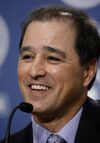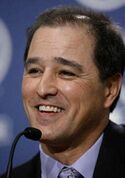Prime Executive of the Kiravian Federacy
| Prime Executive of the Kiravian Federacy
Vèurovektur Kiravix Rektārká | |
|---|---|
| File:PrimeExecutiveStandard.png Standard of the Prime Executive | |
| Abbreviation | PE |
| Member of | Executive College Strategon |
| Residence | Kroveniren Hall |
| Seat | Kartika |
| Term length | Six years (74 months) |
| Constituting instrument | Fundamental Statute |
| Precursor | Confederate High Executive |
| First holder | Ray Lewis |
| Succession | Second Executive Emergency Backup Executive |
| Unofficial names | "Leader of the Coscivian World" |
| Deputy | Second Executive |
| Salary | ₤155,000 |
| Website | www.adikuvvèurovektursk.āri.kr |
The Prime Executive of the Kiravian Federacy is the supreme executive official of the Kiravian Federacy, serving as head of government and performing the duties of head of state on behalf of the Coscivian Emperor. The Prime Executive is involved in the federal legislative process through his power to introduce and veto legislation, and works to maintain the support of a cross-partisan pro-administration camp of Delegates in the Stanora in order to advance a common legislative agenda. He also plays a crucial role in charting and executing the Federacy's foreign and military policies.
The office of the Prime Executive is called the Prime Executure. In Kiravic, the office is known as the Vèurovekturum and the officer as the Vèurovektur. Vèurovektur is a compound of vèurox, which ultimately comes from the Iathei Coscivian vʉrr meaning "first" but took on the meaning of "first and foremost" in High Coscivian before being passed on to Kiravic; and vektur, a High Coscivian title given to various executive officials of the Coscivian Empire.
Constitutional Description
The powers and duties of the Prime Executure are prescribed by the Fundamental Statute.
Eligibility
The Fundamental Statute requires candidates for the Prime Executure to be
- Kiravian citizens from birth
- Resident in a state or incorporated territory of the Federacy for a minimum of 20 years
- At least 30 years of age
- Not members of the Armed Forces or organised militia
- Not a member of a political party in any state
In order to stand for the office of Prime Executive, candidates must be nominated by at least two members of the Federal Council, at least one of whom must be from a state where the candidate does not reside nor have registered domicile.
Enumerated Powers
The Fundamental Statute prescribes the following powers to the Prime Executure:
To introduce legislation to the Federal StanoraThis is technically an Executive College power.- To veto legislation passed by the Stanora (overridable by a supermajority vote)
- To appoint subordinate executive officers
- To issue executive orders and regulatory pronouncements with the force of law
- To command the Kiravian Armed Forces
- To oversee the federal bureaucracy
- To appoint governors of the territories, federal districts, overseas colonies, and other federal subjects
- To revoke and suspend governments of the above with due cause
- To make territorial claims on behalf of the Federacy
- To conduct diplomacy, appoint diplomats, receive foreign envoys, and sign treaties
- To conduct relations with Urom polities
- To appoint federal judges
- To issue pardons and commutations of sentence for convicts in the Federal court system.
Tenure
Elections to the Prime Executure are hexennial. A full Prime Executive term is thus six years (72 months) long, beginning (and ending) at high noon on the twenty-first day of the third full month after the last hexennial election date. Though reckoned by the Coscivian calendar, this date normally falls on 21 December. The tenure of a successor to the Prime Executure expires on the same date that the tenure of the original, elected Prime Executive that they succeeded (directly or indirectly) would have expired.
The Xth Amendment to the Constitution, in effect since 2030, limits an elected Prime Executive to a single, non-renewable term. A successor to an elected Prime Executive may be elected to one full term in his own right after serving the balance of his predecessor's term (or any part thereof). Under no circumstances can a single individual occupy the office for more than 144 months (12 years).[1]
Before 2030 AD, there was no limit to how many terms one individual could serve as Prime Executive. Séan Kæśek held the office over the course of five regular terms (though he did not complete his final term), but was not elected for all of them under normal constitutional arrangements; no other Prime Executive has served more than three terms.
Political and Policy Role
The Prime Executure was originally envisioned as a largely apolitical, custodial office responsible for the impartial execution of Stanora legislation and pragmatic handling of foreign policy and the military. Its two legislative powers, the veto and the power to propose legislation, were included to further separation of powers and help ___________, respectively. Over time, as the power of the federal government and the public profile of the Prime Executure increased, these powers gradually became political in nature, and candidates for the Prime Executure began campaigning on promises to exercise them in support of or opposition to particular policies.
Although primary responsibility for domestic policy on the federal level lies with the Stanora, modern Prime Executives nonetheless play an active role in the process. The Prime Executive plays a critical role in budget negotiations, which involve a balancing of legislative and executive priorities. Prime Executives also participate in policymaking by "sheparding" the adoption of various policies in conjunction with Stanoral allies. The legislative importance of the Prime Executure expands and contracts with the prevailing political attitude of the Stanora. For example, under the Federalist Republican Alliance-dominated Stanora from 21185 to 21206, Prime Executives Rénkédar, Mérovin, and Candrin (all sympathetic to the SRA platform) were able to spearhead major economic and administrative reforms. After a distributist CSU-CR minority government unseated the SRA during Candrin's second term, the Candrin administration largely withdrew from legislative involvement and shifted its attention to foreign, colonial, and military affairs.
Both directly and through various executive branch agencies, the Prime Executive plays a major role in the administration of Kiravia's overseas possessions. The Prime Executive has the authority to levy territorial claims, appoint governors (whether unilaterally, on the advice of a colonial legislature, or from a list of nominees presented by the citizenry), and issue decrees in non-state federal subjects that are not subject to as many constitutional limitations as they would be in full states. The Prime Executive also has the authority to suspend or revoke territorial charters and the governing ordinances of other federal subjects if the local government is found to be in violation of the law.
List of Prime Executives
| Name (birth–death) |
Portrait | Term | State | Notes |
|---|---|---|---|---|
| Ray Lewis | 
|
16XX-16XX | Maryland | Described by historians as "little more than a humorous placeholder", Ray Lewis may have been the first Prime Executive of Kiravia, but he certainly wasn't the last. |
| Ciarán mac Duinnshléibhe | 
|
17XX-17XX | Rovidrea | |
| Andrus Iyerpalan | 
|
17XX-17XX | Province №7 | |
| Meadhrán Érskin | File:Érskin.jpg | 17XX-18XX | Kiorgia | |
| Seridur Revaridon | 
|
18XX-18XX | South Niyaska | |
| Atoverus Verogan | 
|
18XX-18XX | Unknown | |
| Partholón Térunbuir | 
|
19XX-19XX | Kaviska | |
| Séan Kæśek | 
|
1935–1962 | ||
| Eridan Vrixur | 
|
1962-1976 | Hiterna North Æonara |
|
| Céiteach MacCozart | 
|
1976-1982 | Enscirya Thendara |
|
| Ivardus Kólsylvar | 
|
1982-1988 | Iscavia | |
| Kexarin Rénkédar | 
|
1988-2000 | Kensonia | |
| Irasur Mérovin | 
|
2000-2003 | Xirya | |
| H.M. Xosvipelan | 
|
2003-2006 | Harma | |
| Lamar Tannen | 
|
2006-2012 | Váuadra | |
| Andrus Candrin | 
|
2012-2028 | Kaviska | |
| Adheritus Ilkaśvar | 
|
2028-2030 | Ilfenóra | |
| ??? | 
|
2030-2036 | ??? | |
| ??? | 
|
2036-2042 | ??? |
Ceremonial Role
Every eighteen months under the first quarter moon, the Prime Executive conducts a ceremony with the Marble Emperor known as the Triennial Audience, during which the Prime Executive formally briefs the Emperor on conditions in the country and his policy priorities. This ceremony is televised and in modern times serves a political function as a policy address.
The Prime Executive records special broadcast messages for radio and television on the eve of the Coscivian New Year and on Christmas Eve (Coscivian calendar). Both such addresses are non-political in nature: The New Year address conforms to themes of Coscivian cultural continuity and solidarity among the Coscivian nations and peoples of the world, and the Christmas Eve address to themes of universalised Christian ethics and general goodwill. These addresses are broadcast by most radio and television stations across the Federacy and Collectivity. The Prime Executive delivers various other addresses, less widely broadcast or in writing, on other dates of national, religious, historical, and cultural importance, such as Élív.
The Prime Executive is often accorded the unofficial title "Leader of the Coscivian World" (Kiravic: Kódár Koskiekuviúsk) by the domestic press, in recognition of his position as head of the largest and most powerful Coscivian nation.
Amenities
The official residence of the Prime Executive is Kroveniren Hall in Kartika, which also houses the offices of high-level executive branch staff and hosts visiting dignitaries for official state functions. During Kirosocialism, Prime Executives Albumin, ______, and Ástukéter opted to commute to Kroveniren Hall from private homes elsewhere, as did a handful of earlier Prime Executives. In addition to Kroveniren Hall, the Prime Executive has access to two alpine lodges: Tín Líathemyn in County Highland, Province №7 and Trækēston Lodge near Ēsvelter, Kaviska, as well as a disused summer retreat in County Akúvar, Niyaska.
Security for the Prime Executive, his family, and his residences is provided by the Presidential Guard Unit of the Federal Protective Service, an agency of the Security Executive. Former Prime Executives are entitled to PGU protection for life, though at present, both of the two living former Prime Executives (Rénkédar and Mérovin) have chosen to waive this privilege.
- ↑ If a Prime Executive-elect dies or otherwise becomes unable/ineligible to serve during the three month period between the election and the commencement of his term, the Second Executive-elect from his ticket becomes Prime Executive in his stead. It is thus possible to serve the equivalent of two terms if a Second Executive who becomes PE in this way is subsequently elected to a full term of his own.
